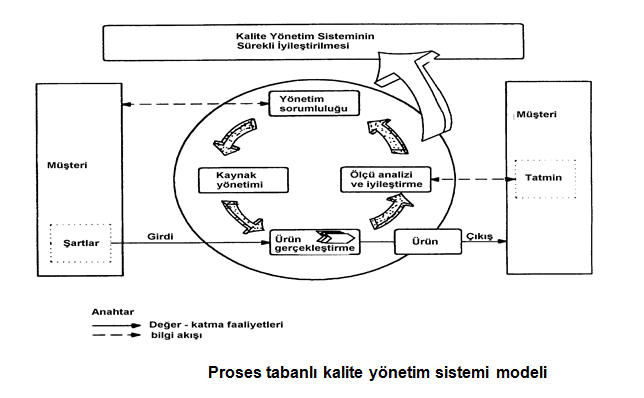The ISO 9001 Quality Management System forms the basis of the professional management system.
target; companies create their own working system, direct company employees to the determined company targets, and ensure the continuous development of the company.
ISO 9001:2008 can be applied in any organization, from the agricultural sector to the industrial sector, from the public to the private sector.
ISO 9001 Quality Management System is a globally accepted form of quality management system published by the International Standards Organization, which envisages increasing customer satisfaction by meeting customer expectations, needs and regulatory requirements.
The purpose of this standard is to reduce and eliminate errors and defects, and more importantly, to prevent errors and defects that may occur.
The standard is not directly related to product and service quality, but is related to the quality of the management system.
The ISO 9001 Standard is not a complete replacement of the existing system of an organization, but the regulation of the system in accordance with the standard conditions.

The ISO 9001 standard defines the requirements that must be applied for the establishment of a quality management system. These requirements are based on eight quality principles. These principles are:
1- Customer Focus: Organizations are dependent on their customers, so they must understand their customers' current and future needs, fully comply with customer requirements, and strive to exceed customer expectations.
2- Leadership: Leaders organize and set unity of direction and purpose. The leader must establish and maintain an environment within the firm so that people can fully participate and engage in the achievement of the organization's goals.
3- Participation of Employees: People at all levels are an asset of the organization, and with their full participation, their abilities can be used effectively for the organization's interests.
4- Process Approach: Successful results can be achieved much more effectively when activities and associated resources are managed as a process. P, Plan .. Set Goals & Processes; U, Apply.. Apply Processes; K, Check.. Watch & Measure; HE, Take Action, Heal.. Provide Continuous Improvement.
5- System Approach to Management:Determining, understanding and managing the interrelated processes as a system ensures the efficiency of the organizations and provides efficiency in the realization of the targets.
6- Continuous Improvement: The continuous improvement of the overall performance of the organization should be a permanent goal of the organization.
7- Realistic Approach in Decision Making: Effective decisions should be used based on analysis of data and information.
8- Supplier Relationships Based on Mutual Interest: An organization and its supplier are interdependent and have mutual interests to increase their ability to create value, and productive relationships must be established in this context.

ISO 9000 STANDARDS SERIES
ISO 9000: It is a set of standards published by ISO that guides organizations in establishing and developing a quality management system to increase customer satisfaction.
ISO 9001: It is the standard that defines the conditions to be applied during the establishment of Quality Management Systems and is subject to certification audit. The name of the given document.
ISO 9001:2008: The ISO 9000 Standard is reviewed by ISO every 5 years and is republished by making necessary revisions in line with the opinions and needs of the implementers. The 2009 number is the version date (ISO 9001:2008 version) indicating that this revision was made and published in 2008.
TS EN ISO 9000 standards consist of four basic standards. These are;
1. TS EN ISO 9000:2005 Quality Management Systems-Basic Concepts, Terms
2. TS EN ISO 9001:2008 Quality Management Systems - Requirements
3. TS EN ISO 9004:2009 Guide for Improving Quality Management System-Performance
4. Inspection Guide for TS EN ISO 19011:2011 Quality and Environmental Management Systems
ARTICLE TITLES OF ISO 9001:2008 STANDARD
1- Scope
2- Referenced standards
3- Terms and definitions
4- Quality management system
5- Management Responsibility
6- Resource Management
7- Product Realization
8- Measurement, Analysis and Recovery
CERTIFICATION PROCESS
An organization that wishes to obtain a certificate according to the ISO 9001 Quality Management System Standard first signs a contract with the certification body authorized to issue this certificate.
Establishes the quality system in the organization in accordance with the requirements of ISO 9001 Quality Management System Standard.
After the necessary preparations are completed, an audit is requested from the certification body.
As a result of the inspection carried out by expert auditors, companies that are registered to meet the minimum requirements of the ISO 9001 standard are certified. The ISO 9001 Certificate is valid for 3 years. During this period, it is ensured that the organization carries out its activities in accordance with the standard conditions by conducting an interim inspection every year, and at the end of 3 years, a certificate renewal inspection is carried out.
Benefits of ISO 9001 Quality Management Management SystemWith the internationally valid ISO 9001 certificate, the chance of competition is increased in market conditions. It is ensured to create a difference compared to the competitors in marketing activities. Institutionalization is ensured by creating a management standard. A systematic management approach is adopted. International commercial advantages are utilized. An increase in customer satisfaction and customer loyalty is ensured. Reduction in wastage and rework. Efficiency is ensured in input, production and final controls. Ease in selection, evaluation and follow-up of suppliers is ensured. Efficiency and profitability increase. A customer-oriented approach is adopted. Continuous improvement in overall performance is ensured. Costs arising from errors and poor quality work are reduced. Intra-company communication improves.